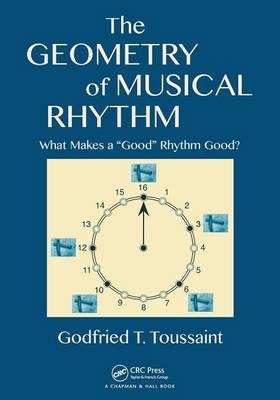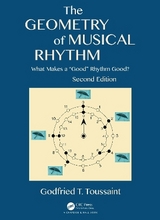
The Geometry of Musical Rhythm
Crc Press Inc (Verlag)
978-1-4665-1202-3 (ISBN)
- Titel erscheint in neuer Auflage
- Artikel merken
Emphasizing a visual geometric treatment of musical rhythm and its underlying structures, the author—an eminent computer scientist and music theory researcher—presents new symbolic geometric approaches and often compares them to existing methods. He shows how distance geometry and phylogenetic analysis can be used in comparative musicology, ethnomusicology, and evolutionary musicology research. The book also strengthens the bridge between these disciplines and mathematical music theory. Many concepts are illustrated with examples using a group of six distinguished rhythms that feature prominently in world music, including the clave son.
Exploring the mathematical properties of good rhythms, this book offers an original computational geometric approach for analyzing musical rhythm and its underlying structures. With numerous figures to complement the explanations, it is suitable for a wide audience, from musicians, composers, and electronic music programmers to music theorists and psychologists to computer scientists and mathematicians. It can also be used in an undergraduate course on music technology, music and computers, or music and mathematics.
What Is Rhythm?
A Steady Beat
Timelines, Ostinatos, and Meter
The Wooden Claves
The Iron Bells
The Clave Son
Six Distinguished Rhythm Timelines
The Distance Geometry of Rhythm
Classification of Rhythms
Binary and Ternary Rhythms
The Isomorphism of Rhythm and Scale
Binarization, Ternarization, and Quantization of Rhythms
Syncopated Rhythms
Keith's Measure of Syncopation
Necklaces and Bracelets
Rhythmic Oddity
Off-Beat Rhythms
Rhythm Complexity
Objective, Cognitive, and Performance Complexities
Lempel-Ziv Complexity
Cognitive Complexity of Rhythms
Irregularity and the Normalized Pairwise Variability Index
Dispersion Problems and Maximally Even Rhythms
Euclidean Rhythms
Leap Years: The Rhythm of the Stars
Approximately Even Rhythms
Rhythms and Crystallography
Complementary Rhythms
Radio Astronomy and Flat Rhythms
Deep Rhythms
Shelling Rhythms
Phantom Rhythms
Reflection Rhythms and Rhythmic Canons
Toggle Rhythms
Symmetric Rhythms
Hourglass Drums and Hourglass Rhythms
Odd Rhythms
Other Representations of Rhythm
Alternating-Hands Box Notation
Spectral Notation
TEDAS and Chronotonic Notation
Rhythmic Similarity and Dissimilarity
Regular and Irregular Rhythms
Evolution and Phylogenesis of Musical Rhythm
Guajira
Rhythmic Combinatorics
What Makes the Clave Son Such a Good Rhythm?
Maximal Evenness
Rhythmic Oddity
Off-Beatness
Weighted Off-Beatness
Metrical Complexity
Main-Beat Onsets and Closure
Distinct Durations
Distinct Adjacent Durations
Onset-Complexity and Distinct Distances
Deep Rhythms, Deepness, and Shallowness
Tallness
Phylogenetic Tree Centrality
Mirror Symmetry
Shadow Contour Isomorphism
The Origin, Evolution, and Migration of the Clave Son
Epilogue
References
Index
| Zusatzinfo | 289 Illustrations, black and white |
|---|---|
| Verlagsort | Bosa Roca |
| Sprache | englisch |
| Maße | 178 x 254 mm |
| Gewicht | 635 g |
| Themenwelt | Kunst / Musik / Theater ► Musik ► Musiktheorie / Musiklehre |
| Mathematik / Informatik ► Mathematik ► Geometrie / Topologie | |
| Naturwissenschaften ► Physik / Astronomie | |
| ISBN-10 | 1-4665-1202-4 / 1466512024 |
| ISBN-13 | 978-1-4665-1202-3 / 9781466512023 |
| Zustand | Neuware |
| Informationen gemäß Produktsicherheitsverordnung (GPSR) | |
| Haben Sie eine Frage zum Produkt? |
aus dem Bereich



